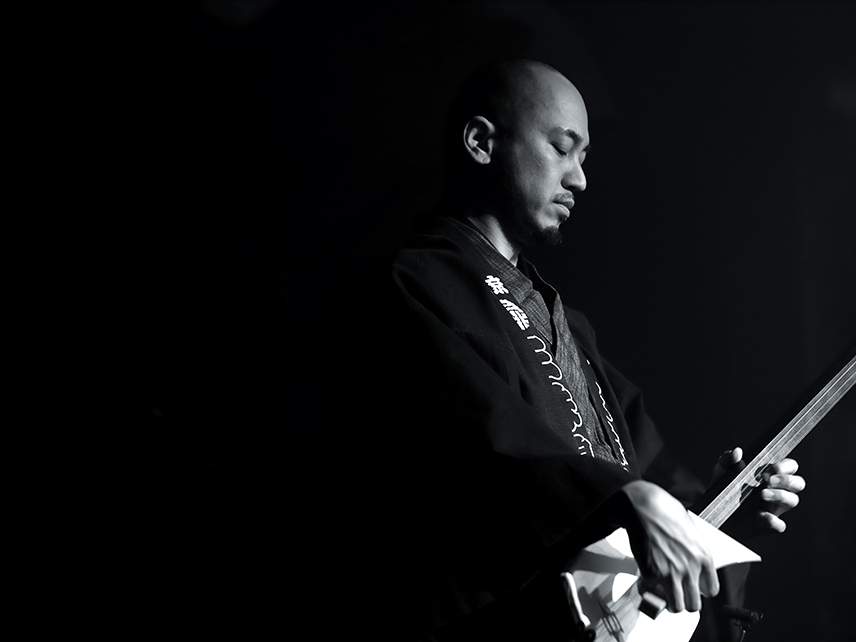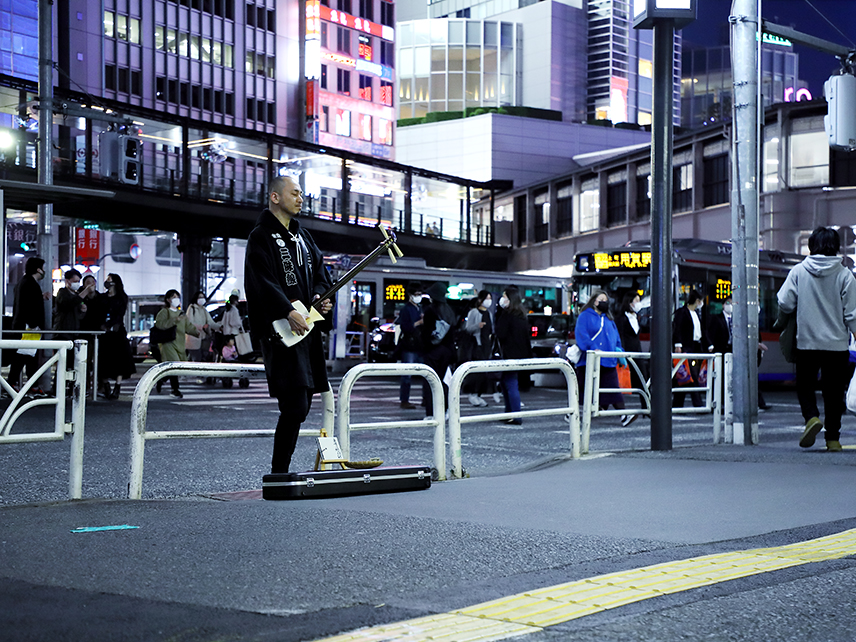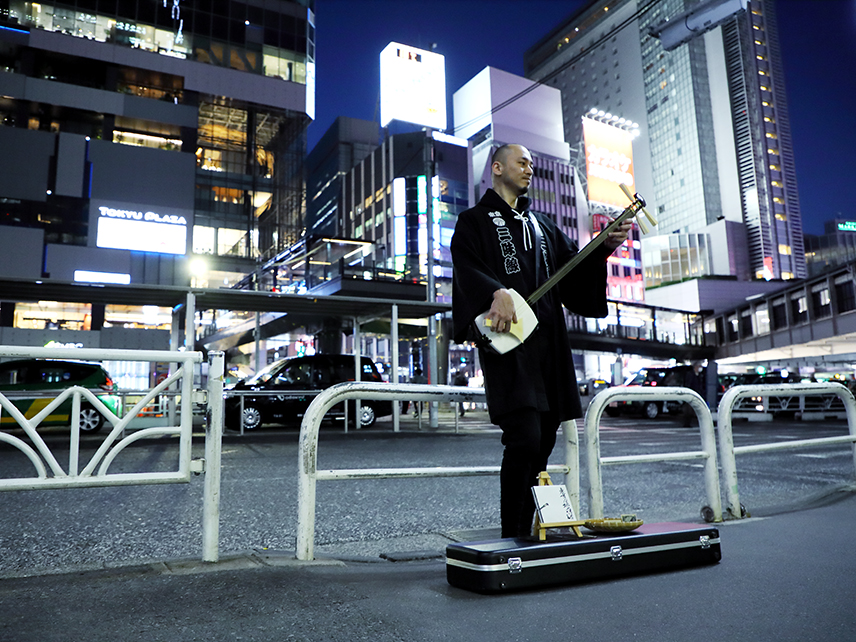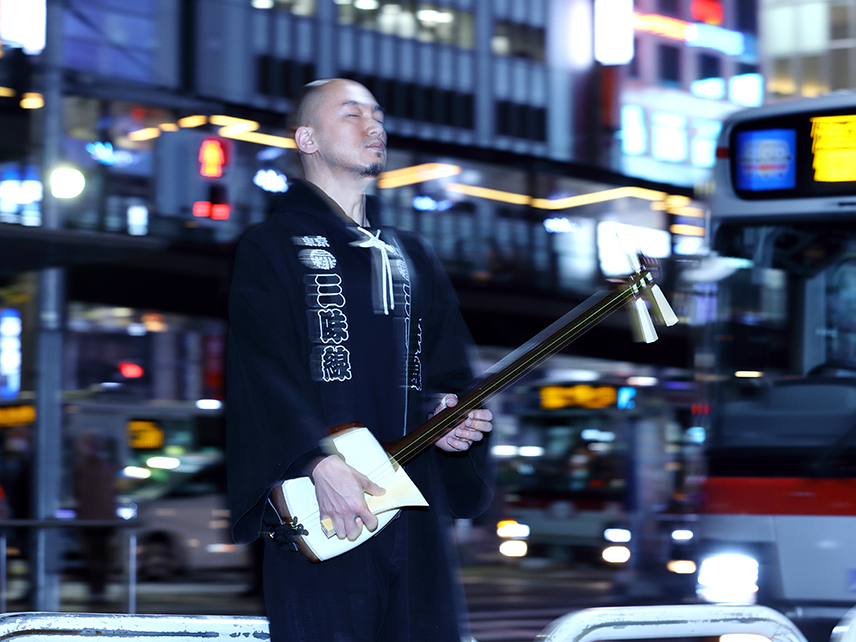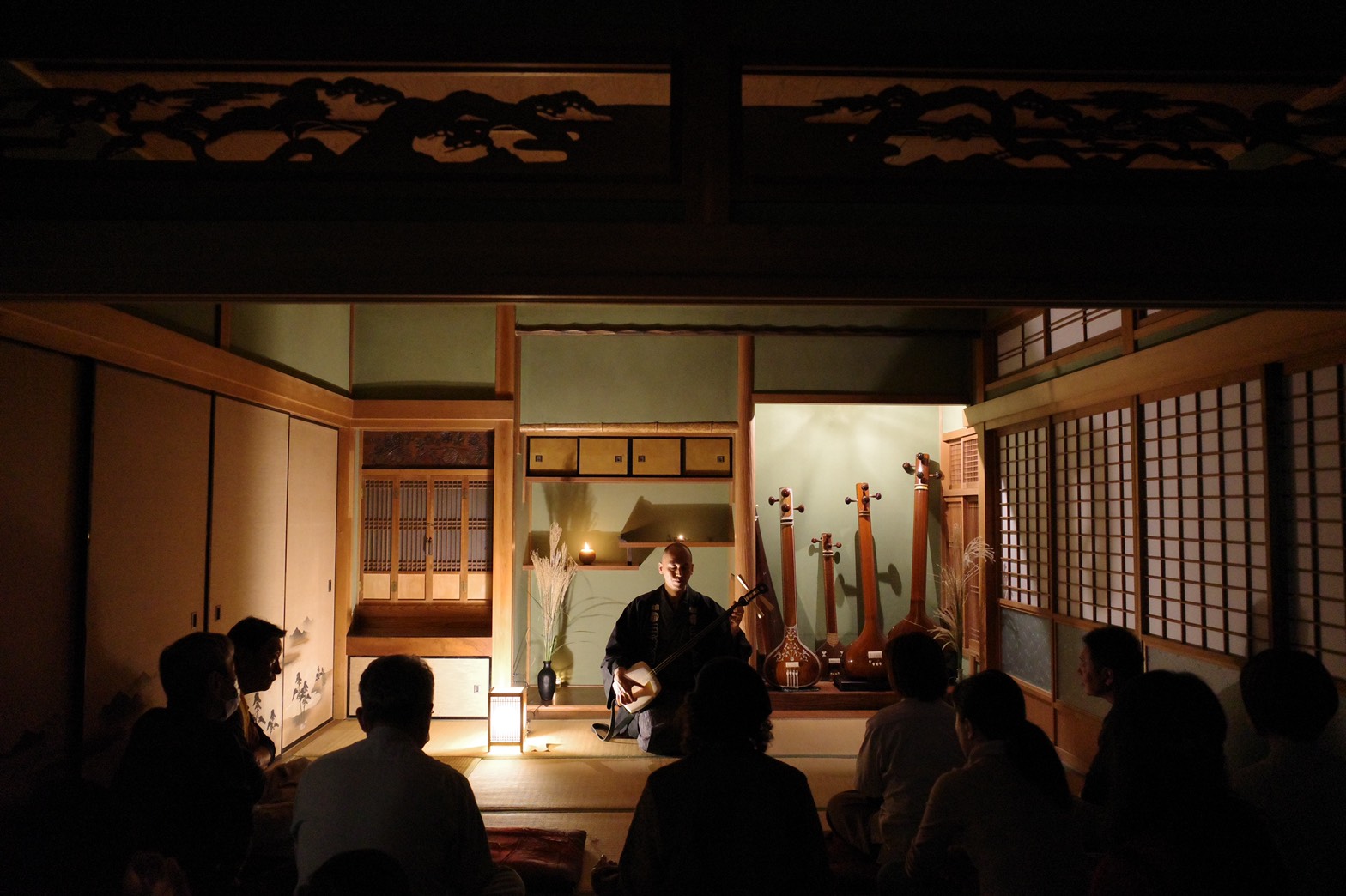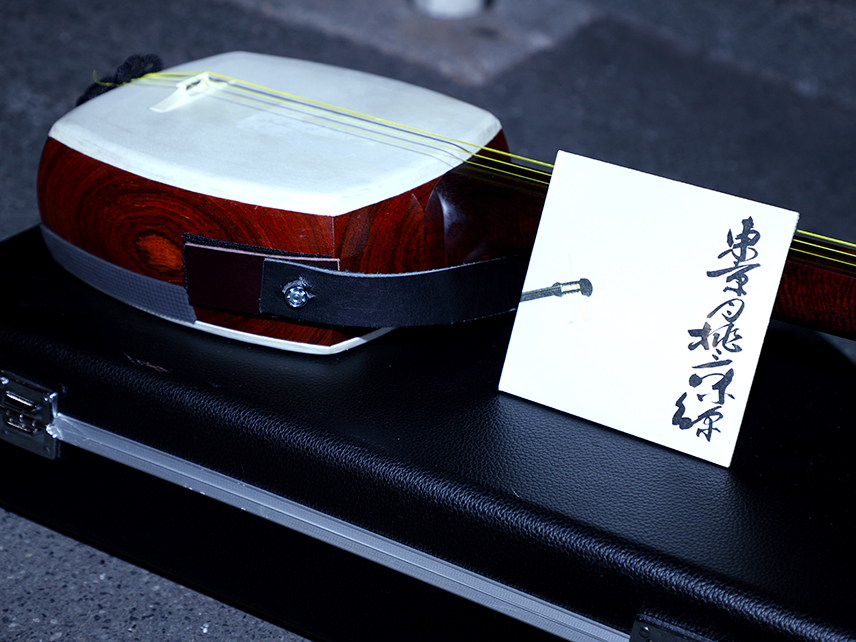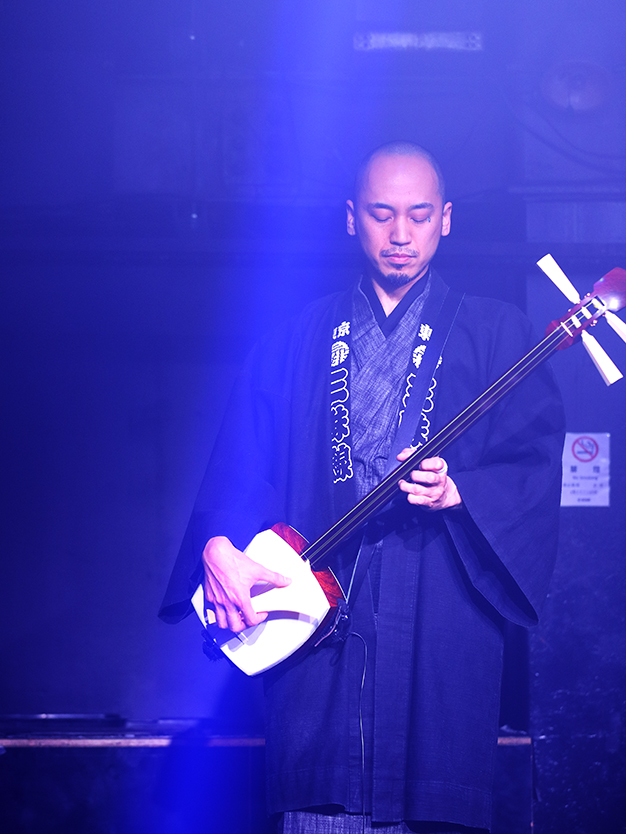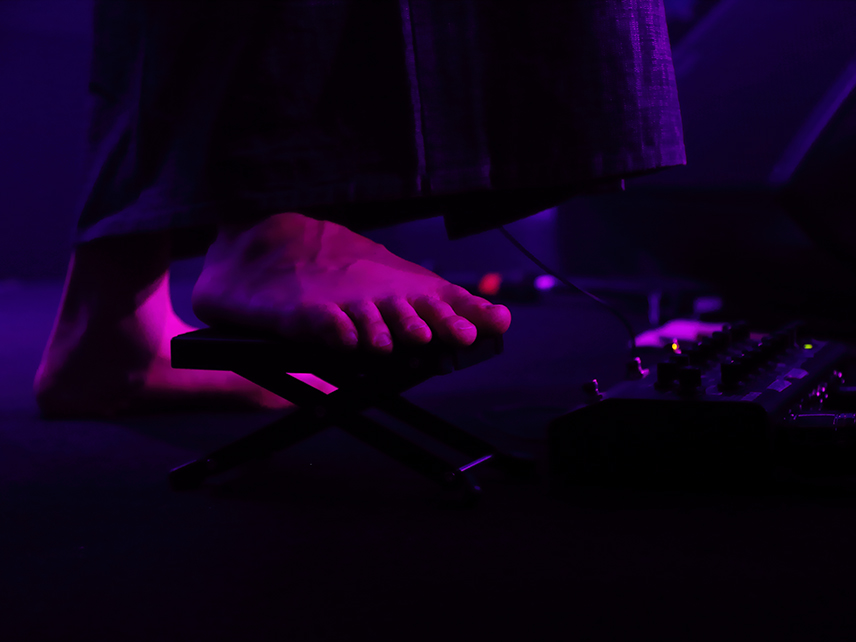There are actually many parts of traditional Japanese culture that attract attention from abroard, yet unfamiliar to Japanese people living in the present age. One of them is the shamisen. Many people must have heard the tone of it but not many of them have faced it squarely. Shamisen is often associated with classicality or abstrusity but Tokyo Ghetto Shamisen would dispel those images. While following the tradition, it is somewhat modern, fits naturally into everyday life, and the complex sound of the three strings moves the listener’s heart.
Where does the music of the Tokyo Ghetto Shamisen come from?
What underlies is the spirit of punk
――What kind of music were you listening to until you got into the shamisen?
Tokyo Ghetto Shamisen: When I was a teenager, my hometown Iwakuni City, Yamaguchi Prefecture, was home to punk, hardcore, and skins culture, and bands from all over the country stopped by there on their tour. Since I grew up there, I started going to a bar and live house that sells records and clothes when I was a junior high school student. Influenced by the spirit of the Punk: Don’t imitate others but be yourself, I became conscious of expressing what I wanted to express in in my own fashion.
――How do you connect to the shamisen from there?
Tokyo Ghetto Shamisen: I moved to Tokyo by myself at the age of 16 and came into contact with various music at live houses and clubs while playing in a band. Gradually, I became fond of the folk music from the other parts of the world and modernized versions of indigenous music, which made me realize that I had never had an opportunity to be exposed to traditional Japanese music nor musical instruments. Also, I was feeling uncomfortable with the fact that contemporary Japanese culture and music are just following Western culture. These feeling and realization, along with my previous experience in guitar made me decide to play the shamisen for the first time in 2008.
――How did you feel when you played it for the first time?
Tokyo Ghetto Shamisen: When I first learned how to hold a plectrum and how to make one note from a shamisen teacher, I was fascinated by the rich overtones and the beauty of the lingering sound. I felt that even a simple sequence of these comfortable notes would become music, so I decided to face this instrument on instinct without being bound by stereotypes. As a result, immediately after learning basic methods almost without listening to the existing shamisen songs, I started playing improvisation on the streets of Tokyo.
――There are many people who know the shamisen as an instrument, but do not know it in detail. Can you explain it briefly?
Tokyo Ghetto Shamisen: The shamisen is said to be an instrument invented based on the sanshin that was introduced to Sakai in Osaka via Ryukyu at the end of the Warring States period in the 15th and 16th centuries. It is said that the origin of it dates back to the traditional Chinese instrument Sanxian.
The roots of Japanese shamisen music are “Joruri” and “Jiuta”. It is believed that Jiuta as a shamisen music was first created by the group of visually impaired Buddhist priests /music players (lute priests) who were narrating The tale of Heike with music. They made some improvements in the existing instrument to create the shamisen and played it with plectrum originally used for the pipa.
Since the Edo period, , it has been used for folk songs as well in line with the emergence of many genres such as “Nagauta” and “Gidayu-bushi”. Triggered by the development of shamisen music, the shamisen itself has been developed variedly to be best suited to respective types of music. Currently, it is said that there are more than a dozen types, but in general, they are classified into three types according to the thickness of the neck: “small neck”, “middle neck”, and “thick neck”. I’m using the shamisen with thick neck.
Music started on the street and was nurtured in the blessings of nature
――Where have you been playing the shamisen until now?
Tokyo Ghetto Shamisen: When I first started, what I was looking for in music was the liberation of the soul, the sound of nowness rooted in the times and climate. I expressed it through my own performances at the places where I was hanging around at the time: on the streets of Tokyo, at clubs, live houses, and bars. Thanks to the various people I met there, I started to get opportunities to play on domestic and international stages such as dedication performances at shrines and temples, local festivals and music festivals.
――So it all started from the street where you were playing, right?
Tokyo Ghetto Shamisen: That’s right. Playing on the street is my starting point and a place for learning, so I continue to do it as a life work even now. Normally, people compose their own work after learning the classics well, but as I mentioned earlier, my case was the other way around. In order to make my sound fit into the hustle and bustle of Tokyo where I was living at that time, I developed my own style and song while intuitively playing the sounds in improvisational performances and sessions from the beginning. After establishing the world of sounds that I want to express and the standards of my favorite tones, I started to learn from traditional shamisen music.
――How did you learn traditional shamisen music?
Tokyo Ghetto Shamisen: In 2013, I studied under Eizan Takahashi, the leading disciple of The first Chikuzan Takahashi, a recognized authority in the Tsugaru shamisen, and learned the Takeyama style Tsugaru shamisen. Since then, I have been learning the classical shamisen music from teachers with many different specialty such as local folksong, Shinai, Nagauta. Among them, there are many playing styles, rhythms, intervals that modern Japanese cannot think of. When you touch the performances of past masters and classical songs, you will feel the soul and way of life of your predecessors, the breath of the times and the climate, as well as the universal beauty. I think that learning and communicating it is the act of nurturing the life of the art that continues to live beyond the life of one person, and connecting the soul’s sash to the future. By learning face-to-face with masters, I often learn from their humanity apart from their music, and I feel that performing arts deeply color life and everyday life of someone.
――You have moved your base to Kyoto, right?
Tokyo Ghetto Shamisen: It’s been about 9 years since I moved to Kyoto. Even before that, I liked to compose in the nature of places I went for a tour, and I was also interested in farming and self-sufficiency apart from music activities. So I was experiencing farming in the fields of my friends living close to Tokyo. Eventually, I started to envisioned a lifestyle in which I engage with creative activity and a self-sufficient life while living close to nature, and go to various parts of the country if I had the opportunity to perform.
――Why did you choose Kyoto?
Tokyo Ghetto Shamisen: In Kyoto, the city is located close to nature, and there are many places and opportunities to learn traditional culture. Besides, the natural and healthy food culture is firmly imbedded in their lifestyle, and the authentic music culture is still alive. In 2012, I moved to the foot of Mt. Hiei because I was drawn to the fact that these wonderful cultures coexist in festivals, parties, and everyday life to form a unique cultural sphere. Furthermore, at the end of last year, I moved to a small village in the mountains about two hours away from the city, and I am enjoying a life in the countryside more than ever.
――How is your life in the countryside?
Tokyo Ghetto Shamisen: My place is located in a quiet environment surrounded by mountains, rivers and fields with clean air and water. It is a perfect environment for sitting down to practice and create something. There is no place to shop in my neighborhood, but I don’t feel any inconvenience because now we have an internet and sometimes I travel 20 to 30 minutes to go for shopping. Observing the subtle changes in nature that are difficult to feel when living in the city, I spend each day creating, farming.
――Are there any changes after you started to work on composition in nature on a daily-basis?
Tokyo Ghetto Shamisen: Nature has an overwhelming amount of information, so I feel that there is already music made up of only the sounds of nature even without human intervention. When composing in nature, I often hit the note with the feeling of gently adding sounds so as not to disturb them, and complete the music with the silence and environmental sounds that appear in the meantime. In the environment I’m living now, I am more than ever able to find beauty in silence, lingering sound, the ephemeral moment when the sound is disappearing, and the moment in between.
I’ve heard that unlike the most of populations in the world, Japanese tend to use the left hemisphere (language brain) to perceive natural sounds such as sounds of insects, sounds of wave, sounds of wind, sounds of rain and the sounds of a rushing creek as a word emitted from nature, instead of just recognizing them as noise. Since the shamisen is an instrument made in the Japanese climate and architectural environment based on such a sensibility, I feel that the sound of it is compatible with traditional buildings and residences. I also like the echo of the house I live in, so I sometimes invite my neighbors to hold concerts.・ CAP
――The album released last year for the first time in about 7 years contains 22 songs in a 2-disc set. The year and place of production are also listed for each song. There are also songs made in Vietnam.
Tokyo Ghetto Shamisen: In recent years, there have been more opportunities to perform in East and Southeast Asian countries such as China, South Korea, and Thailand, and I have been learning from interaction with local traditional musicians. In the dry season of Vietnam, the shamisen sounded very well and the live performance got a favorable reception from the audiences. The song “Renka” was made in my room at the hotel in Da Nang through a session with the erhu-like sound heard from the next room.
Artworks of the album jacket was co-designed by Usugrow (moon), Toshikazu Nosaka (flying dragon), Shinsaku Arakawa (photography) and others
――It’s wonderful to have a session with the person in the next room. The album jacket was shot by Shinsaku Arakawa, who is worked on interdisciplinary art project “kawa / river”, and I was also interested in the artwork inside by Toshikazu Nosaka and Usugrow.
Tokyo Ghetto Shamisen: I’ve known Nosaka since he spoke to me on the street when I started playing the shamisen, and he has written logos for me and done live paintings alongside of my performance. In terms of Usugrow, we’ve known each other since a live painting performance event we did together, I have also done performances at the site where he worked on mural paintings and at his solo exhibitions in Taiwan.
I met Shinsaku on the streets of Kyoto. I have played the shamisen at his projects and events to commemorate the publication of “kawa/ river”. I was often inspired by the interactions and the works with them, and we are all close friends as well. For my album, I asked them for help because I wanted to give a concrete shape to this great connection. By the way, the title “Tokyo Ghetto Shamisen” is now written by my late grandfather.
Expressing emotions is one of the desires
――The connections started from your point of origin: the street and the shamisen. So, is there anything you would like to challenge in the future?
Tokyo Ghetto Shamisen: Since long ago, when I got an image of sound in my mind, I also got an image of video footages along with it in my mind, but I have never had a chance to create a video work that embodies it, so I would like to challenge video production. And the biggest challenge would be to continue to improve my performance and composition throughout my life and continue to produce my own masterpiece.
――Oh, I will look forward to it. Finally, what kind of music do you want to make in the future?
Tokyo Ghetto Shamisen: For me, act of composing sounds has been to expressing through the shamisen sound the nature and flow of life energy (chi) felt at the moment when something overflows from me, such as when impressed or awed by the beauty of nature, or when moved by the subtleties of someone’s emotion. I don’t think that will change in the future, but in addition to those that are connected to my own experience and reality, I also want to make a more abstract or fantastical music that stirs my imagination and makes my soul tremble.
For me, creating and playing sounds is an instinctive desire and pleasure, so I would like to continue to face music more delicately and purely, and pursue universal beauty through it.
When I genuinely want to play a sound and share it with someone else, I feel like I am praying for the peace of mind of everyone. I believe the music starts with the tuning of yourself and the instrument, and it leads to the tuning of the listener’s soul and space. So I will continue to devote myself to the music that will heal, save, and feeds someone’s mind, even for one person or a moment.
Tokyo Ghetto Shamisen
In 2008, he started his musical career in Tokyo, aiming for indigenous music rooted in the Japanese culture and climate. In 2012, he relocated his base to Kyoto, and made the life of facing the soil and feeling the subtleties of nature through self-sufficiency farming as the basis of his creative activities. He has performed extensively on various stages in Japan and overseas, including shrines and temples, on the streets, in nature. Through these artistic practices and collaboration with various musicians and artists, he is working on unique shamisen music that lives in the present age.
http://tokyo-ghetto-shamisen.com
Instagram: @tokyo_ghetto_shamisen
Twitter: @AtsushiSakata
Bandcamp: https://tokyo-ghetto-shamisen.bandcamp.com/
Photography Yuji Sato
Translation Shinichiro Sato

